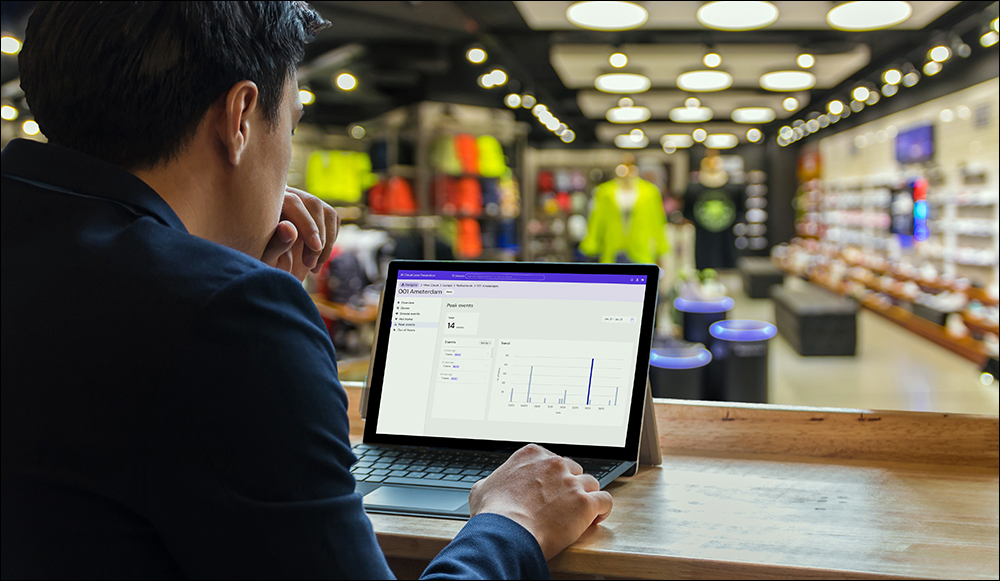Presented here are recent news announcements regarding the following organizations: Nedap, Semtech, SAS Institute, Memfault, Alif Semiconductor, CenTrak, Infinite Leap and Loftware.
Nedap Announces Cloud-based RFID Loss-Prevention System
Nedap, a provider of RFID solutions, has announced the launch of its iD Cloud Loss Prevention solution, designed to help retailers detect, quantify and prevent losses. This solution is part of Nedap’s iD Cloud platform, an integrated suite of software-as-a-service solutions intended to boost inventory visibility. iD Cloud Loss Prevention, the company explains, enables retailers and brands to track every unique item at critical areas in their stores via RFID, both at the point of sale and at entrances and exits.
The platform’s algorithm can automatically detect suspicious events, such as goods leaving a store in bulk or outside of normal operating hours, as well as identify products more likely to be stolen. For loss prevention to be an omnichannel enabler, the company notes, businesses must look beyond single theft events. Thus, Nedap says, the algorithm was designed to recognize theft and fraud patterns over time.

By identifying which items have a higher theft risk, Nedap explains, brands and retailers can discover shrinkage trends that otherwise might have gone unnoticed and thereby combat organized retail crime, theft and fraud. This allows stores to improve shopping experiences for customers, such as mobile checkouts, “buy online, pickup in store” (BOPIS) and receiptless returns, without uncontrollable shrinkage levels.
”We envision that every retailer creates seamless shopping experiences without shrink,” said Oscar van den Broek, Nedap’s managing director, in a prepared statement. “No loss, no matter where, should go unnoticed. Today’s shoppers demand a seamless shopping experience. In-store shopping should feel like online shopping: easy, fast and without any queues or barriers. Retailers that fail to bring this frictionless experience into their stores will lose customers and their stores will become increasingly irrelevant.”
Semtech, SAS Institute Collaborate on IoT Solutions for North Carolina Town
Semtech, a supplier of analog and mixed-signal semiconductors and algorithms, has announced a collaboration with the SAS Institute and the Town of Cary, North Carolina, to improve the overall quality of life for the town’s citizens, while minimizing environmental footprint and reducing waste. SAS, Semtech and the Town of Cary are teaming up to build a Center of Excellence focused on technology solutions that will positively impact citizens’ lives. Through the collaboration, the partners will facilitate the development of edge-to-cloud Internet of Things (IoT) solutions, in the hope of making Cary a benchmark for other municipalities.
A previous SAS and Cary IoT collaboration, designed to address stormwater flood alerting, received multiple smart-city innovation awards, the companies report. “This partnership represents an exciting new chapter in our IoT journey,” said Nicole Raimundo, the town’s chief information officer. “We see so much potential for community-focused solutions in this collaboration with Semtech and SAS. We believe that IoT technology has amazing potential to streamline services, making us more agile and responsive. It will help us continue to meet citizen needs in surprising new ways, and we’re honored by these companies’ commitment to improving lives through innovation in the government space.”
Jason Mann, the SAS Institute’s VP of IoT, added in the statement: “IoT is forcing a fundamental shift of business and operational strategies as organizations adopt new models for agile IT, edge analytics and platform-based security. The Town of Cary adopting SAS and Semtech solutions will expand their current services while building a digital infrastructure to better meet the needs of their citizens.”
The solutions will incorporate LoRaWAN connectivity with SAS’s IoT analytics platform to simplify the development of IoT systems focused on natural disasters, hunger and sustainability. “The Center of Excellence will be a leading example of how cities and towns in the U.S. can leverage IoT data and analytics for a smarter, safer planet,” said Alistair Fulton, the VP and general manager of Semtech’s Wireless and Sensing Products Group, in the prepared statement. “In addition, deploying these IoT solutions will create better community services for their residents.”
Memfault, Alif Semiconductor Partner on Processors for IoT Developers
Memfault, the provider of a cloud-based connected device observability platform, has announced that it has partnered with Alif Semiconductor, a supplier of secure, connected, AI-enabled microcontrollers and fusion processors. The edge-processing technology in Alif’s Ensemble and Crescendo product families will be paired with Memfault’s cloud-based diagnostic tools for embedded devices, the companies report, enabling IoT device developers to build and launch products at speed.
The Ensemble family is built on embedded processing technology that can scale from a single Arm Cortex-M55 MCU to multi-core fusion processors that blend up to two Cortex-M55 MCU cores, up to two Cortex-A32 microprocessor cores capable of running high-level operating systems, and up to two Arm Ethos-U55 microNPUs for artificial intelligence and machine learning acceleration. Ensemble family devices contain a secure enclave that provides multiple layers of security, such as device integrity protection, secure identity and strong root-of-trust, and secure lifecycle management.
According to the companies, the Ensemble family is suitable for smart-home products, appliances, point-of-sale applications, robotics and more. The Crescendo family offers the same functionality as the Ensemble family, but with LTE Cat-M1 and NB-IoT Cellular connectivity added in, as well as GNSS positioning.
As MCUs become capable of applications like AI and have global connectivity, the companies explain, lab testing cannot anticipate or simulate all environments, which leaves devices susceptible to software bugs. Product makers are thus burdened with direct resource costs due to troubleshooting devices in the field with only raw logs, a lack of analytics to correlate multi-factored device states, and varied use cases across many devices, all of which can ruin brand reputation.
“Memfault is excited to partner with Alif Semiconductor to give their customers who are developing incredibly sophisticated embedded applications access to Memfault’s device observability platform,” said Francois Baldassari, Memfault’s CEO, in a prepared statement. “Alif’s forward-thinking strategy to build a development and operational software management ecosystem around their innovative microcontrollers makes them a great solution for today’s intelligent edge devices and an ideal partner for Memfault.”
Mark Rootz, Alif Semiconductor’s senior marketing director, added in the statement: “A key part of Alif’s mission is to streamline and simplify the development of smart, power-efficient connected devices. The high level of functional integration in our MCUs and fusion processors, combined with highly flexible software enablement solutions, such as Memfault’s device observability platform, sets developers on a path to be productive right away, and lets them deploy their products to the market faster.”
CenTrak Acquires Healthcare RTLS Company Infinite Leap
CenTrak, a Halma company, has announced its purchase of Infinite Leap, a healthcare consulting and services provider for real-time location system (RTLS) technologies. The acquisition is intended to expand CenTrak’s capabilities and partner ecosystem, the company reports, while enabling healthcare organizations to improve patient outcomes and substantiate their investment in RTLS solutions.
“The acquisition of Infinite Leap and their seasoned team will accelerate the development of a robust managed services program for CenTrak,” said David Minning, CenTrak’s president and CEO, in a prepared statement. “Infinite Leap has provided extensive clinical consulting services for years, and by bringing their experts on board, we can scale more quickly, provide enhanced post go-live support, and introduce on-site assessment services to ensure customers are successfully optimizing their location technology.”
CenTrak will integrate the services currently performed by Infinite Leap, ranging from solution design and business planning to implementation, training, operational support, managed services and program optimization. Existing Infinite Leap customers will continue to receive support, install new systems and carry out expansions under the umbrella of CenTrak’s offerings.
“Collaborating with CenTrak throughout a highly successful, multi-year partnership has demonstrated the importance of offering RTLS solutions and managed services to benefit the customer, and we’re excited to continue our work and jointly expand our capabilities,” added Mark Rheault, Infinite Leap’s founder and CEO, in the statement. “I look forward to combining the talent of these two organizations and joining the CenTrak leadership team, together we will further drive the impact of RTLS in healthcare and improve the patient experience.”
Loftware Adds New RFID Drivers to Labeling Software
Loftware, a software company offering enterprise labeling and artwork-management solutions, has announced NiceLabel 10, part of its NiceLabel portfolio, which also includes NiceLabel Cloud and NiceLabel Label Management System. This new release offers a top-level view of users’ labeling operations and streamlines printer management, the company reports, thereby saving time, adding control and expanding their ability to manage print resources via the cloud. This update adds new drivers that enable RFID functionality on certain printers.
NiceLabel 10’s interface includes a redesign of the software’s Control Center, with each page redesigned to provide information to users faster, as well as a dashboard that allows a one-glance view of key labeling activities. NiceLabel Cloud and the Control Center are intended to help end users and partners collaborate in the cloud, according to the company, with partner co-branding for better communication with customers.
Honeywell has added support for its new PX240 and PX240S printer models, as well as RFID functionality on its DP printers. This includes HF tags (EPC Class 1 [64 bit], EPC Class 1 [96 bit], UCODE EPC 1.19 and EPC 18000-6B) and UHF tags (EPC Class 1 Gen 2). The supported RFID functionality, apart from encoding tags, includes reading and printing; support for locking, unlocking, permanent locking and permanent unlocking; antenna offset; and setting up a number for retries.
NiceLabel 10 offers Web-based printer management, which the company says improves the efficiency of managing printers, making it easier to keep printers up to date and running while reducing demand on IT. This is facilitated by role-based access controls that determine permissions for printer groups. Additionally, Web-based printer driver provisioning streamlines the management of print devices so users can install and update printer drivers remotely and manage printer settings online.
Cupix Updates Its 3D Digital-Twin Platform for Construction
Cupix, a provider of 3D digital-twin solutions for the architecture, engineering and construction industries, as well as facility owners, has announced Site Insights, a new progress-tracking feature of its CupixWorks 3D digital-twin platform. The system is designed to keep owners informed regarding projects, the company reports. The platform combines information capture, ingestion, data analysis and context into a single system of tracking and managing construction progress, Cupix explains.
Site Insights quantifies jobsite context and progress data to help users make actionable, data-driven decisions. The software is intended to ensure projects remain on schedule and on budget, and to reveal the time required to generate subcontractor invoices based on the percentage of completed work. It can capture, quantify and share percentage metrics regarding deviations that building elements experience between original building information management (BIM) files and as-built progress. This reduces errors and rework, the company explains, and provides a metric to save time and expenses for owners and project managers.
Since job sites frequently change, the software provides as-built updating, error identification and rework prevention, payment reconciliation, and progress and schedule updates. Onsite updating of BIM files is sometimes ignored or happens on only a quarterly basis, Cupix explains, but with Site Insights, BIM managers and virtual design and construction specialists can streamline and share as-built updates. In addition, critical errors can be missed or overlooked onsite, so the software can analyze data captured alongside BIM files, reducing the incidence of deviations and site misses.
Owners, project managers and supervisors can determine when to generate invoices for general contractors and subcontractors, preventing delays. And with better access to progress data on a regular basis, Cupix notes, project managers can schedule the flow of goods and services to prevent late deliveries. Site Insights is currently available via an invitation-only pilot program for AEC firms and building owners, the company reports, and it is being deployed at construction sites worldwide. The pilot is intended to reveal use cases and capabilities before the solution is made generally available during the first half of next year.


